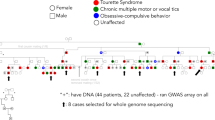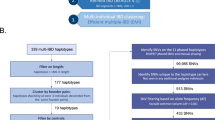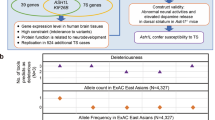Abstract
Gilles de la Tourette syndrome is a complex neuropsychiatric disorder, which becomes evident in childhood between the ages of 2 and 15 years. Tourette syndrome is defined by the occurrence of a large range and variable number of unwanted repetitive simple or complex motor and vocal tics that start in childhood and follow a waxing and waning course. A major gene for this syndrome has not yet been identified, probably owing to both genetic and phenotypic heterogeneity of this disease. This article describes the clinical evaluation of patients and family members in a large Dutch Gilles de la Tourette Syndrome pedigree and the decisions encountered with respect to phenotyping. The importance of an accurate definition of the Tourette phenotype is discussed, which is highly important for reliable genetic linkage and association studies. Subsequent linkage analysis resulted in three linkage peaks on different chromosomes 3q, 9q, and 13q. Multipoint analysis resulted in a single linkage peak with logarithm of odds score 2.55 with marker D3S1311 on chromosome 3q.
This is a preview of subscription content, access via your institution
Access options
Subscribe to this journal
Receive 12 print issues and online access
$259.00 per year
only $21.58 per issue
Buy this article
- Purchase on Springer Link
- Instant access to full article PDF
Prices may be subject to local taxes which are calculated during checkout




Similar content being viewed by others
References
DSM-IV task force. Tic disorders. In: Frances A, Pincus HA, First MB (eds). Diagnostic and Statistical Manual of Mental Disorders, 4th edn. American Psychiatric Association: Washington, DC, pp 100–105.
Jankovic J . Tourette's syndrome. N Engl J Med 2001; 345: 1184–1192.
Leckman JF, Cohen DJ, Goetz CG, Jankovic J . Tourette syndrome: pieces of the puzzle. Adv Neurol 2001; 85: 369–390.
Leckman JF, Zhang H, Vitale A, Lahnin F, Lynch K, Bondi C et al. Course of tic severity in Tourette syndrome: the first two decades. Pediatrics 1998; 102: 14–19.
American Psychiatric Association. Diagnostic and Statistical Manual of Mental Disorders, 4th edn. Washington, DC, 1994.
Albin RL, Mink JW . Recent advances in Tourette syndrome research. Trends Neurosci 2006; 29: 175–182.
Verhulst FC . Mental Health in Dutch Children. Thesis, Erasmus University Rotterdam, 1985.
Singer HS . Current issues in Tourette syndrome. Mov Disord 2000; 15: 1051–1063, review.
Apter A, Pauls DL, Bleich A, Zohar AH, Kron S, Ratzoni G et al. An epidemiologic study of Gilles de la Tourette's syndrome in Israel. Arch Gen Psychiatry 1993; 50: 734–738.
Pauls DL, Raymond CL, Stevenson JM, Leckman JF . A family study of Gilles de la Tourette syndrome. Am J Hum Genet 1991; 48: 154–163.
Van de Wetering BJ, Heutink P . The genetics of the Gilles de la Tourette syndrome: a review. J Lab Clin Med 1993; 121: 638–645.
Pauls DL . Update on the genetics of Tourette syndrome. Adv Neurol 2001; 85: 81–293.
Olson S . Making sense of Tourette's. Science 2004; 305: 1390–1392.
Walkup JT . Epigenetic and environmental risk factors in Tourette syndrome. Adv Neurol 2001; 85: 273–279, review.
Price LH, Kidd K, Cohen DL . A twin study of Tourette syndrome. Arch Gen Psychiatry 1985; 42: 815–820.
Taylor LD, Krizman DB, Jankovic J, Hayani A, Steuber PC, Greenberg F et al. 9p monosomy in a patient with Gilles de la Tourette's syndrome. Neurology 1991; 41: 1513–1515.
Boghosian-Sell L, Comings DE, Overhauser J . Tourette syndrome in a pedigree with a 7;18 translocation: identification of a YAC spanning the translocation breakpoint at 18q22.3. Am J Hum Genet 1996; 59: 999–1005.
Matsumoto N, David DE, Johnson EW, Konecki D, Burmester JK, Ledbetter DH et al. Breakpoint sequences of an 1;8 translocation in a family with Gilles de la Tourette syndrome. Eur J Hum Genet 2000; 8: 875–883.
Kroisel PM, Petek E, Emberger W, Windpassinger C, Wladika W, Wagner K . Candidate region for Gilles de la Tourette syndrome at 7q31. Am J Med Genet 2001; 101: 259–261.
Verkerk AJMH, Mathews CA, Joosse M, Eussen BHJ, Heutink P, Oostra BA, Tourette Syndrome Association International Consortium for Genetics. CNTNAP2 is disrupted in a family with Gilles de la Tourette syndrome and obsessive compulsive disorder. Genomics 2003; 82: 1–9.
State MW, Greally JM, Cuker A, Bowers PN, Henegariu O, Morgan TM et al. Epigenetic abnormalities associated with a chromosome 18(q21–q22) inversion and a Gilles de la Tourette syndrome phenotype. Proc Natl Acad Sci USA 2003; 100: 4684–4689.
Crawford FC, Ait-Ghezala G, Morris M, Sutcliffe MJ, Hauser RA, Silver AA et al. Translocation breakpoint in two unrelated Tourette syndrome cases, within a region previously linked to the disorder. Hum Genet 2003; 113: 154–161.
Abelson JF, Abelson JF, Kwan KY, O'Roak BJ, Baek DY, Stillman AA et al. Sequence variants in SLITRK1 are associated with Tourette's Syndrome. Science 2005; 310: 317–320.
Pauls DL . The genetics of Tourette syndrome. Curr Psychiatry Rep 2001; 3: 152–157.
The Tourette Syndrome Association International Consortium for Genetics. A complete genome screen in sib pairs affected by Gilles de la Tourette syndrome. Am J Hum Genet 1999; 65: 1428–1436.
Merette C, Brassard A, Potvin A, Bouvier H, Rousseau F, Emond C et al. Significant linkage for Tourette syndrome in a large French Canadian family. Am J Hum Genet 2000; 67: 1008–1013.
Simonic I, Gericke GS, Ott J, Weber JL . Identification of genetic markers associated with Gilles de la Tourette syndrome in an Afrikaner population. Am J Hum Genet 1998; 63: 839–846.
Simonic I, Gericke GS, Ott J, Weber JL . Further evidence for linkage of Gilles de la Tourette syndrome (GTS) susceptibility loci on chromosomes 2p11, 8q22 and 11q23–24 in South African Afrikaners. Am J Med Genet 2001; 105: 163–167.
Zhang H, Leckman JF, Pauls DL, Tsai C-P, Kidd KK, Campos MR . Tourette syndrome association international consortium for genetics. Genomewide scan of hoarding in sib pairs in which both sibs have Gilles de la Tourette syndrome. Am J Hum Genet 2002; 70: 896–904.
Curtis D, Brett P, Dearlove AM, McQuillin A, Kalsi G, Robertson MM et al. Genome scan of Tourette syndrome in a single large pedigree shows some support for linkage to regions of chromosomes 5, 10 and 13. Psychiatr Genet 2004; 14: 83–87.
Paschou P, Feng Y, Pakstis AJ, Speed WC, DeMille MM, Kidd JR et al. Indications of linkage and association of Gilles de la Tourette Syndrome in two independent family samples: 17q25 is a putative suscetibility region. Am J Hum Genet 2004; 75: 545–560.
Leckman JF, Riddle MA, Hardin MT, Ort SI, Swartz KL, Stevenson J et al. The Yale Global tic severity scale: initial testing of a clinician-rated scale of tic severity. J Am Acad Child Adolescent Psych 1989; 28: 566–573.
Goodman WK, Price LH, Rasmussen SA, Mazure C, Fleischman RL, Hill CL et al. The Yale-Brown obsessive-compulsive scale II. Validity. Arch Gen Psychiatry 1989; 46: 1012–1016.
Goodman WK, Price LH, Rasmussen SA, Mazure C, Delgado P, Heninger GR et al. The Yale-Brown obsessive-compulsive scale II. Validity. Arch Gen Psychiatry 1989; 46: 1012–1016.
Barr CL, Wigg KG, Pakstis AJ, Kurlan R, Pauls D, Kidd KK et al. A genomescan for linkage to Gilles de la Tourette syndrome. Am J Med Genet 199; 88: 437–445.
Robertson MM, Banerjee S, Kurlan R, Cohen DJ, Leckman JF, McMahon W et al. The Tourette syndrome diagnostic confidence index: development and clinical associations. Neurology 1999; 53: 2108–2112.
Breedveld GJ, van Dongen JW, Danesino C, Guala A, Percy AK, Dure LS et al. Mutations in TITF-1 are associated with benign hereditary chorea. Hum Mol Genet 2002; 11: 971–979.
Ott J . Computer-simulation methods in human linkage analysis. Proc Natl Acad Sci USA 1989; 86: 4175–4178.
Weeks DE, Lehner T, Squires-Wheeler E, Kaufmann C, Ott J . Measuring the inflation of the lod score due to its maximization over model parameter values in human linkage analysis. Genet Epidemiol 1990; 7: 237–243.
Lathrop GM, Laouel JM . Easy calculations of lodscores and genetic risks on a small computer. Am J Hum Genet 1984; 36: 460–465.
Lathrop GM, Lalouel JM, Julier C, Ott J . Strategies for multilocus linkage analysis in humans. Proc Natl Acad Sci USA 1984; 1: 251–257.
Cottingham Jr RW, Idury RM, Schäffer AA . Faster sequential genetic linkage computations. Am J Hum Genet 1993; 53: 252–263.
Schäffer AA, Gupta SK, Shriram K, Cottingham Jr RW . Avoiding recomputation in linkage analysis. Hum Hered 1994; 44: 225–237.
Sobel E, Lange K . Descent graphs in pedigree analysis: applications to haplotyping, location scores, and marker sharing statistics. Am J Hum Genet 1996; 58: 1323–1337.
Curtis D, Brett P, Kearlove AM, McQuillin A, Kalsi G, Robertson MM et al. Genome scan of Tourette syndrome in a single large pedigree shows some support for linkage to regions of chromosomes 5, 10 and 13. Psych Genet 2004; 14: 83–87.
Pauls DL, Leckman JF . The inheritance of Gilles de la Tourette's syndrome and associated behaviors. Evidence for autosomal dominant transmission. N Engl J Med 1986; 315: 993–997.
Heutink PH, van de Wetering BJM, Pakstis AJ, Kurlan R, Sandor P, Oostra BA et al. Linkage studies on Gilles de la Tourette Syndrome: what is the strategy of choice? Am J Hum Genet 1995; 57: 465–473.
O'Connell JR, Weeks DE . Pedcheck: a program for identification of genotyping incompatibilities in linkage analysis. Am J Hum Genet 1988; 63: 259–266.
Lander E, Kruglyak L . Genetic dissection of complex traits: guidelines for interpreting and reporting linkage results. Nat Genet 1995; 11: 241–247.
Hartung H, Feldman B, Lovec H, Coulier F, Birnbaum D, Goldfarb M . Murine FGF-12 and FGF-13: expression in embryonic nervous system, connective tissue and heart. Mech Dev 1997; 64: 31–39.
Hatakeyama J, Sakamoto S, Kageyama R . Hes1 and hes5 regulate the development of the cranial and spinal nerve systems. Dev Neurosci 2006; 28: 92–101.
Sugo T, Murakami Y, Shimomura Y, Harada M, Abe M, Ishibashi Y et al. Identification of urotensin II-related peptide as the urotensin II-immunoreactive molecule in the rat brain. Biochem Biophys Res Comm 2003; 310: 860–868.
Pauls DL . Update on the genetics of Tourette Syndrome. In: Cohen DL, Goetz CG, Jankovic J (eds). Tourette syndrome In Advances in Neurology series; 85, Chapter 22. Lippincott, Williams & Wilkens: Philadelphia, 2001, pp 281–293.
Cath DC, van Grootheest DS, Boomsma DI, Smit J . Defining the obsessive-compulsive phenotype for research purposes: do the experts who select the patients form a rate-limiting step? Submitted.
Sweeney JA, Takarae Y, Macmillan C, Luna B, Minshew NJ . Eye movements in neurodevelopmental disorders. Curr Opin Neurol 2004; 17: 37–42.
Alsobrook II JP, Leckman JF, Goodman WK, Rasmussen SA, Pauls DL . Segregation analysis of obsessive-compulsive disorder using symptom-based factor scores. Am J Med Genet 1999; 88: 669–675.
Mathews CA, Jang KL, Herrera LD, Lowe LT, Budman CL, Erenberg G et al. Tic symptoms in subjects with Tourette syndrome from two genetically isolated populations. Biol Psychiatry, in press, 2006. Epub ahead of print: doi:10.1016/j.biopsych.2006.02.009.
Acknowledgements
We acknowledge the family members for their cooperation. This work was supported by grants from the US National Institutes of Health (NS-40024-01) to AJMHV and DCC. We thank Dr M State for supplying the SLITRK1 primers.
Author information
Authors and Affiliations
Corresponding author
Rights and permissions
About this article
Cite this article
Verkerk, A., Cath, D., van der Linde, H. et al. Genetic and clinical analysis of a large Dutch Gilles de la Tourette family. Mol Psychiatry 11, 954–964 (2006). https://doi.org/10.1038/sj.mp.4001877
Received:
Revised:
Accepted:
Published:
Issue Date:
DOI: https://doi.org/10.1038/sj.mp.4001877
Keywords
This article is cited by
-
The genetics of Tourette syndrome
Nature Reviews Neurology (2012)
-
Pathogenetic model for Tourette syndrome delineates overlap with related neurodevelopmental disorders including Autism
Translational Psychiatry (2012)
-
The Leucine-Rich Repeat Superfamily of Synaptic Adhesion Molecules: LRRTMs and Slitrks
Molecules and Cells (2012)
-
Tourette disorder spectrum maps to chromosome 14q31.1 in an Italian kindred
neurogenetics (2010)
-
Thinning of the Motor–Cingulate–Insular Cortices in Siblings Concordant for Tourette Syndrome
Brain Topography (2009)



